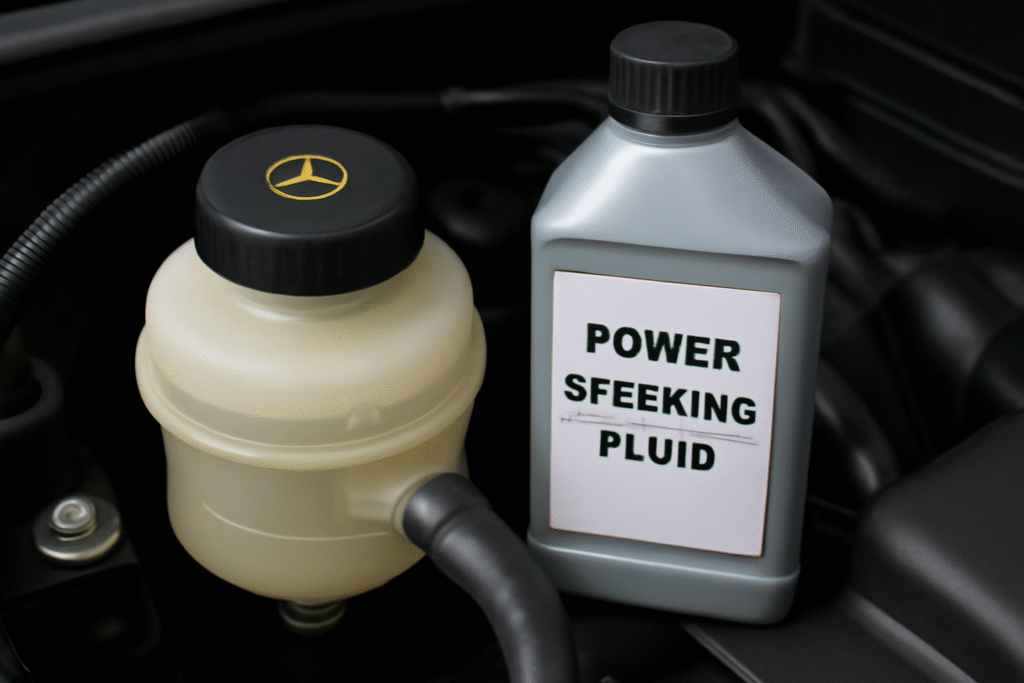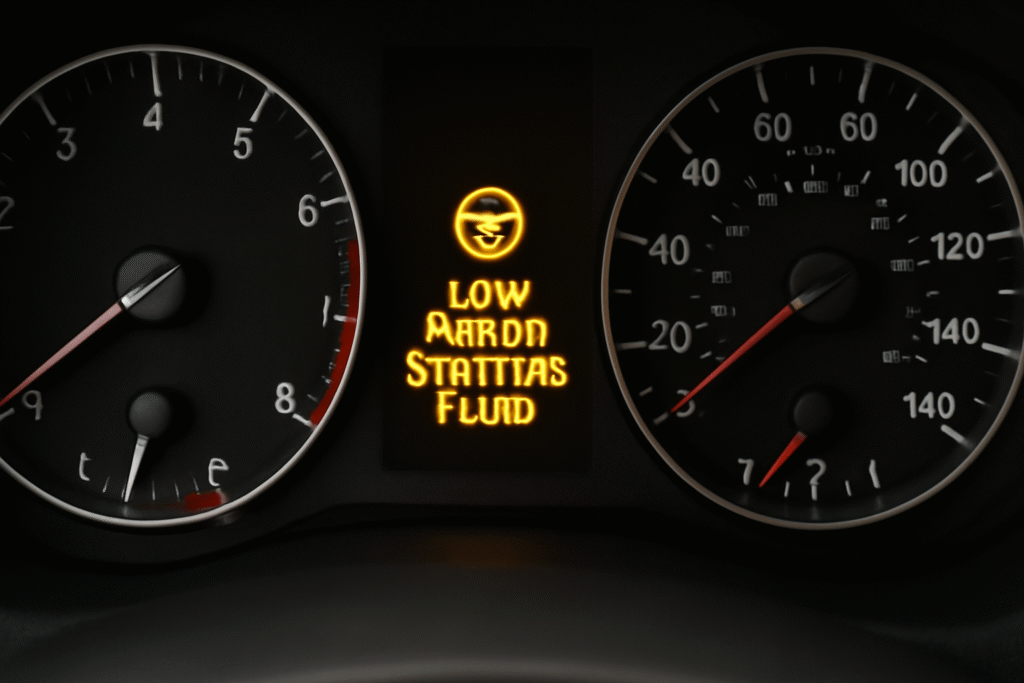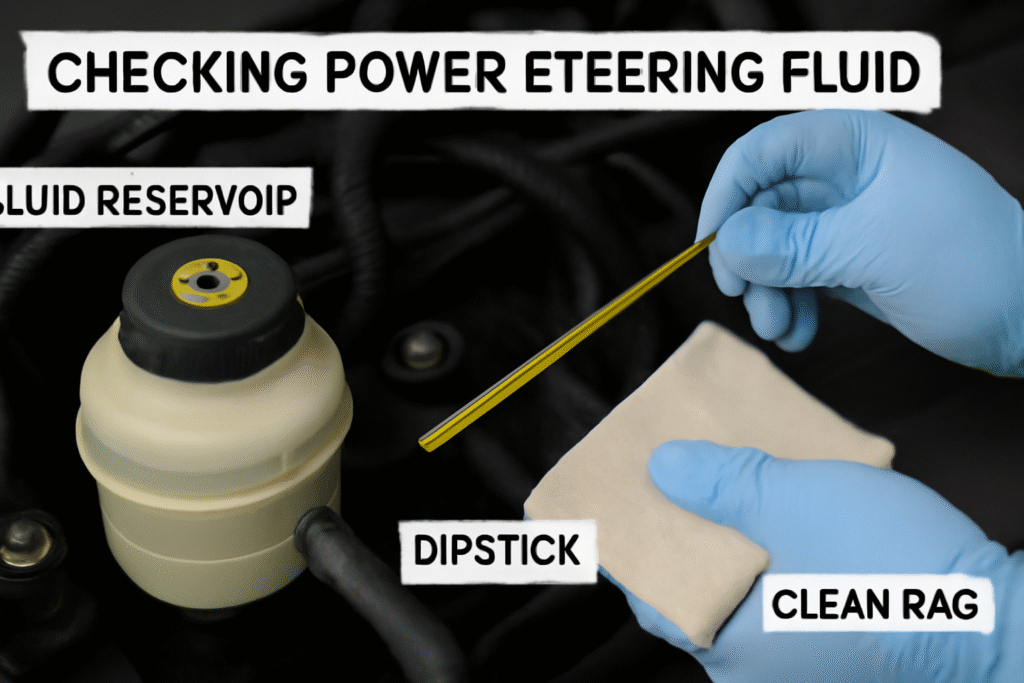
How to Check and Refill Power Steering Fluid: A Step-by-Step Guide for Smooth Driving
If you’ve ever experienced the frustration of stiff, unresponsive steering or heard a strange whining noise while turning your wheel, you might be dealing with low power steering fluid. 
But how to check and refill power steering fluid? Don’t worry — it’s easier than you might think! In this step-by-step guide, we’ll walk you through the simple process of checking and refilling your power steering fluid, ensuring your steering stays responsive and your driving experience stays smooth.
Table of Contents
ToggleWhat Is Power Steering Fluid and Why Is It Important?
Power steering fluid is the lifeblood of your vehicle’s steering system. It’s a special hydraulic fluid that helps you turn the steering wheel with ease, especially at low speeds or when parking. Without it, steering can become difficult, heavy, and even unsafe. Let’s break down why this fluid is so essential for smooth driving.
What Is Power Steering Fluid?
Power steering fluid is a type of hydraulic fluid that helps transmit power within the steering system. It works by applying pressure to the steering mechanism, making it easier for you to turn the wheel with minimal effort. The fluid also lubricates the components within the steering system, ensuring smooth movement and reducing friction.
Why Is Power Steering Fluid Important?
- Ensures Smooth Steering: The primary role of power steering fluid is to assist in the movement of the steering wheel. When the fluid level is low or the fluid is old and contaminated, you may experience stiff or unresponsive steering.
- Prevents Wear and Tear: The fluid acts as a lubricant, protecting the steering pump and other critical parts of the power steering system from damage caused by friction. Without enough fluid, components like the pump can wear out quickly, leading to expensive repairs.
- Keeps the System Cool: In addition to lubrication, power steering fluid helps keep the system cool. As the pump works, it generates heat. The fluid absorbs and dissipates this heat, ensuring the system doesn’t overheat and fail.

Signs of Low or Contaminated Fluid
If the power steering fluid is low or contaminated, you might experience:
- Whining or squealing noises when turning the steering wheel
- Stiff or jerky steering
- Difficulty turning at low speeds
Maintaining the correct level of fresh, clean power steering fluid is crucial to avoid these issues and keep your steering system functioning properly.

Signs That Your Power Steering Fluid Needs Checking
Your car’s power steering system relies on a specific amount of fluid to work properly. If it’s running low or contaminated, it can cause a variety of problems. Here’s how to spot the signs that it’s time to check your power steering fluid:
1. Unresponsive Steering 
If your steering wheel feels stiff or hard to turn, especially at low speeds, it could be a sign of low fluid. You might notice it’s more difficult to steer when parking or making tight turns. This happens because the power steering system can’t generate enough hydraulic pressure to assist in turning the wheel.
2. Unusual Noises 
Hearing whining or squealing sounds when turning the steering wheel is another red flag. This could mean the fluid level is low, and the pump is working harder than usual to push the fluid through the system. The sound typically gets louder the faster you drive, or when you turn the wheel all the way in one direction.
3. Vibration or Stiffness 
If the steering wheel feels shaky or vibrates as you turn, this could indicate a power steering problem. Low fluid levels can cause the steering components to grind against each other, leading to these unsettling vibrations.
4. Dashboard Warning Light 
Some modern vehicles come equipped with a power steering warning light that will illuminate if there’s an issue with the fluid level or the power steering system. If this light comes on, it’s crucial to check your fluid level as soon as possible to avoid further damage.
5. Visible Leaks 
While it’s not always easy to spot, power steering fluid leaks around hoses, the pump, or the steering rack are common. If you notice a puddle of red or brown fluid under your car, it’s time to check the system for any leaks and top off the fluid.
How to Check Power Steering Fluid: Step-by-Step
Checking your power steering fluid is a simple yet important maintenance task that can save you from bigger problems down the road. Follow these easy steps to check your fluid level and ensure your steering system is running smoothly.
Step 1: Prepare Your Vehicle 
Before you start, make sure your car is on a flat surface. Park your vehicle and turn off the engine. It’s best to wait a few minutes to allow the fluid to settle and give you an accurate reading.
Step 2: Locate the Power Steering Fluid Reservoir 
In most vehicles, the power steering fluid reservoir is easily identifiable by a cap marked with a steering wheel icon. It’s typically located near the engine, either near the front of the engine bay or on the side. If you’re unsure of the exact location, refer to your car’s owner’s manual.
Step 3: Check the Fluid Level
- With a Dipstick: If your car has a dipstick attached to the cap, remove it, wipe it clean with a rag, then insert it back into the reservoir. Pull it out again to check the fluid level. The fluid should be between the “MIN” and “MAX” marks.
- Without a Dipstick: For cars that don’t have a dipstick, you’ll need to open the cap and visually check the fluid level. The fluid should be clearly visible inside the reservoir. If the fluid is low, it’s time to top it up.
Step 4: Inspect the Fluid Condition 
The condition of the fluid is just as important as the level. Power steering fluid should be a clear or light pinkish color. If it’s dark, brown, or has a burnt smell, this indicates it’s time for a fluid change or a flush. Healthy fluid will help the power steering pump operate smoothly, while contaminated fluid can cause strain on the system.
Step 5: Replace the Cap 
Once you’ve checked the fluid, make sure to securely tighten the cap back in place. A loose cap can lead to leaks, reducing the fluid level and causing further problems.

How to Refill Power Steering Fluid: Step-by-Step
Refilling power steering fluid is a simple process that you can do yourself to maintain smooth steering and prevent further damage to your vehicle. Follow these easy steps to top up your power steering fluid the right way.
Step 1: Choose the Right Fluid 
Before refilling, make sure you have the correct type of power steering fluid for your car. Refer to your owner’s manual for specific recommendations, as some cars require a particular type of fluid (e.g., ATF or dedicated power steering fluid). Using the wrong fluid can damage the system.
Step 2: Open the Fluid Reservoir Cap 
Once you’ve located the power steering fluid reservoir (as explained in the previous section), remove the cap. Keep a clean cloth or paper towel handy to wipe away any dirt or grime from the cap to avoid contamination.
Step 3: Add Fluid Slowly 
Using a funnel, slowly add the recommended power steering fluid into the reservoir. Be cautious not to overfill! Add small amounts at a time, checking the fluid level frequently to avoid spilling.
Step 4: Check Fluid Level Again 
After adding the fluid, start the engine and let it run for a minute. Turn the steering wheel a few times from left to right to help circulate the fluid through the system. Recheck the fluid level using the dipstick or by visually inspecting the reservoir. Add more fluid if necessary, but avoid overfilling.
Step 5: Replace the Cap 
Once the fluid is at the correct level, securely screw the cap back onto the reservoir to prevent any leaks or contamination.
Step 6: Test the Steering 
Now that you’ve refilled the fluid, test the steering by turning the wheel. If it feels smooth and easy to turn, you’ve done it correctly. If you still hear whining noises or the steering feels stiff, there may be a deeper issue, like a leak or air in the system, that requires professional attention.

Common Mistakes to Avoid When Refilling Power Steering Fluid
Refilling power steering fluid seems like a straightforward task, but there are a few common mistakes that can cause more harm than good. Avoid these pitfalls to keep your steering system in top condition.
1. Using the Wrong Fluid 
Not all power steering fluids are created equal. Using the wrong type can cause serious damage to your system. Always check your car’s manual for the recommended fluid type (e.g., ATF, synthetic, or standard power steering fluid). Don’t make the mistake of assuming all fluids are the same!
2. Overfilling the Reservoir 
It might be tempting to add as much fluid as possible, but overfilling can lead to leaks, foaming, and erratic steering behavior. Always add fluid gradually, checking the level frequently to ensure you stay within the “MIN” and “MAX” marks.
3. Ignoring Fluid Condition 
Power steering fluid can get contaminated over time. If the fluid is dark, thick, or has a burnt smell, it’s not just low — it’s time for a fluid change or flush. Don’t make the mistake of just topping off dirty fluid; this can cause more damage in the long run.
4. Not Checking for Leaks 
If your power steering fluid is consistently low, there could be a leak in the system. Failing to address this issue can lead to bigger problems. Always inspect the hoses and reservoir for any signs of leaks after refilling. If you find a leak, it’s time for a professional inspection.
5. Refilling Without Testing 
After refilling, always test your steering. Turn the wheel fully to the left and right a few times to help circulate the fluid. This ensures everything is working properly. Don’t assume that topping off the fluid alone will fix steering issues—always test the result.

How Often Should You Check and Refill Power Steering Fluid?
Regular maintenance is key to keeping your power steering system in top shape. But how often should you check and refill your power steering fluid? Let’s break it down.
1. Every 6 to 12 Months 
As a general rule of thumb, you should check your power steering fluid level every 6 to 12 months, or during regular oil changes. This ensures you catch any potential fluid loss before it becomes a bigger issue. Even if you don’t notice any problems, regular checks are important for long-term vehicle health.
2. Before Long Trips or Seasonal Changes 

If you’re planning a road trip or experiencing a change in weather (e.g., from summer heat to winter cold), it’s a good idea to inspect your power steering fluid beforehand. Extreme temperatures can affect the fluid’s viscosity, so checking levels before hitting the road can prevent steering issues while driving.
3. When You Notice Issues 
If you experience any of the signs mentioned earlier — like hard steering, whining noises, or a dashboard warning light — check the fluid right away. Addressing issues early on can prevent unnecessary damage and costly repairs.
4. If You’ve Had a Power Steering Repair 
After a repair or replacement of any power steering components, it’s wise to check the fluid more frequently. Leaks or improper refills can occur during repairs, so monitoring the fluid level can help you spot any problems right away.
What to Do if You Find a Leak
Finding a power steering fluid leak can be concerning, but it’s important to act quickly to prevent further damage to your vehicle. Here’s what to do if you discover a leak in your power steering system.
1. Locate the Source of the Leak 
The first step is to pinpoint where the leak is coming from. Common places for leaks include:
- Hoses: Cracks or loose fittings can cause leaks.
- Power Steering Pump: If the pump itself is leaking, it may need replacement.
- Steering Rack: Leaks here can be harder to spot but still need attention.
- Reservoir: Check for cracks or signs of damage on the fluid reservoir.
If you’re unsure where the leak is, you can try wiping the area clean and then running the engine for a short time. Look for fresh fluid to help identify the leak’s location.
2. Add Fluid Temporarily (If Necessary) 
If you’re unable to get your car to a mechanic right away, you can temporarily add more fluid to the reservoir to keep the steering system functioning. This will allow you to drive to a repair shop or until you can address the issue, but keep an eye on the fluid level — it may continue to drop if the leak is substantial.
3. Don’t Ignore the Leak 
Even if the leak seems small, don’t wait to address it. Leaking power steering fluid can lead to significant steering issues, and continuing to drive with low fluid levels can damage the pump, hoses, or other critical components of the system.
4. Visit a Professional Mechanic 
A power steering fluid leak isn’t something that should be ignored. Take your vehicle to a mechanic as soon as possible. They can fix the leak and ensure your steering system is properly repaired. If it’s a major leak, it could lead to further complications, including complete power steering failure.

Maintaining the right level of power steering fluid is a simple yet crucial part of vehicle upkeep. By regularly checking and refilling the fluid, you can prevent steering issues, protect your car’s power steering system from damage, and enjoy a smoother, safer driving experience.
Remember, it’s not just about topping up the fluid when it gets low — keep an eye on its condition, watch for leaks, and address any problems early on. Whether you’re a seasoned car owner or a beginner, following these steps will help ensure your steering remains smooth and reliable for years to come.
So, take a few minutes to check your power steering fluid, and enjoy the confidence of knowing your car is ready for the road!

Frequently Asked Questions (FAQ)
1. How do I know if my power steering fluid is low?
If your steering feels stiff, especially at low speeds, or if you hear whining or squealing noises when turning the wheel, your power steering fluid may be low. You can also check the fluid level directly using the dipstick or by opening the reservoir cap to see if the fluid is below the “min” mark.
2. Can I use any type of fluid for power steering?
No, you should always use the type of power steering fluid recommended in your car’s owner’s manual. Different vehicles require specific fluids (e.g., ATF or power steering fluid), and using the wrong type can damage the power steering pump or system.
3. How often should I check my power steering fluid?
It’s recommended to check your power steering fluid every 6-12 months, or during regular oil changes. If you notice issues like hard steering or unusual noises, it’s a good idea to check the fluid level sooner.
4. Can I drive with low power steering fluid?
Driving with low power steering fluid is not recommended. It can make steering harder, especially at low speeds, and can cause long-term damage to the power steering pump and other system components. If you notice low fluid, top it up as soon as possible.
5. How do I refill power steering fluid?
To refill, locate the power steering fluid reservoir, remove the cap, and add the correct type of fluid. Use a funnel to avoid spills, and add fluid gradually, checking the level to ensure it’s between the “min” and “max” marks.
6. Can overfilling power steering fluid cause problems?
Yes, overfilling power steering fluid can cause leaks and erratic steering behavior. Always check the fluid level and ensure it stays within the recommended range to avoid damaging the system.
7. What should I do if I see a power steering fluid leak?
If you notice a leak, locate the source (often hoses, the steering pump, or the reservoir). Temporarily top up the fluid if necessary and visit a mechanic to get the leak properly fixed, as ignoring it can lead to further damage.
8. How do I know if my power steering fluid is dirty?
Healthy power steering fluid is typically clear or light pinkish. If the fluid appears dark brown or smells burnt, it’s likely contaminated and should be replaced or flushed to prevent damage to the power steering components.




